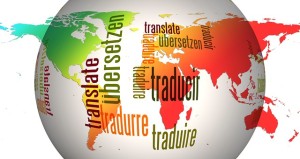A couple of years ago I completed a course called “Curso de Traductor-Corrector”, which is a proofreading course for translators. I decided to attend the course because many times I had to carry out both tasks when dealing with a translation project into Spanish; not only did I have to translate a document but I had also the thrilling responsibility to deliver a final version which should be perfect in style, grammar, format, consistency and so on.  Everything should be near perfection. Sometimes I felt that I lacked the tools to approach texts with such a fine-tooth comb and sometimes I felt that I had a better command of the English language than that of my own. After completing the course, my mind and critical eye started to play tricks on me and I realized that I could not read even a small piece of text without analyzing it thoroughly or without trying to correct what I knew was wrong. Everything I read was under judgment: my husband’s notes over the fridge, inscriptions on T-shirts, street signs, the information on the toilet paper package, my head was so full of new concepts and ideas that I could not stop putting into practice all the information I was still processing. I would like to share some basic concepts I was taught:
Everything should be near perfection. Sometimes I felt that I lacked the tools to approach texts with such a fine-tooth comb and sometimes I felt that I had a better command of the English language than that of my own. After completing the course, my mind and critical eye started to play tricks on me and I realized that I could not read even a small piece of text without analyzing it thoroughly or without trying to correct what I knew was wrong. Everything I read was under judgment: my husband’s notes over the fridge, inscriptions on T-shirts, street signs, the information on the toilet paper package, my head was so full of new concepts and ideas that I could not stop putting into practice all the information I was still processing. I would like to share some basic concepts I was taught:
When editing a text after translating it:
What should be corrected after translating a text into Spanish?
When the Spanish language translator has to perform correction duties, he has to be objective; he cannot make changes that have to do with his personal taste or style. His specific task consists of correcting mistakes in the following fields:
1) Graphic mistakes: punctuation, spelling rules, capital letters.
2) Morphological mistakes: verb tenses, gender.
3) Syntactic mistakes: grammatical concordance, correct use of prepositions.
4) Semantic mistakes: repetitions, ambiguity.
5) Lexical mistakes: Gallicisms, anglicisms, neologisms.
When correcting a text that has been previously translated into Spanish, the following items have to be carefully revised:
1) Extremely long sentences. They should be split into shorter ones.
2) The incorrect use of connectors. Connectors are responsible for the production of a coherent text and they can have different meanings depending on the context they are inserted so; the language translator has to make sure they are not wrongly used in a Spanish text.
3) Punctuation. Punctuation marks are used to structure a piece of text, to limit phrases and paragraphs, to show emphasis on main ideas, to put secondary ideas in the correct order, and to avoid ambiguity. Auxiliary punctuation marks are also essential if the text includes decimal numbers or figures where the comma, if it is wrongly placed can alter the meaning of the text.
4) Unnecessary repetitions.
5) Rhyming among words.
6) The use of the article.
7) The use of the gerund, which in Spanish, is wrongly used in many occasions.
8) The underuse and the overuse of prepositions.
9) Concordance between nouns and adjectives.
10) Presentation of titles and the use of capital letters.
These are some of the most important aspects to keep in mind when correcting a text that has been previously translated into Spanish (or any other language). Of course, there are many other important aspects that have to do with the specific field of expertise of the translated text. I have just mentioned some general rules that I always keep in mind when revising my own translations or the work of a colleague. I hope you can find this article useful. You will see how much you can improve your own work as a Spanish language translator!
Cecilia A. Spanish Translator, Argentina
+14 years of experience
Any Language ~ Any Context ~ Any Time
Accurate Language Services provides high quality, foreign language translation solutions in all languages. We are dedicated to offering cost-effective, superior translation services. Click HERE to learn more about our translation solutions or call our office at 732-898-9144 to discuss your next translation project with one of our Project Managers.












